What Is Inbound Marketing? A Guide to Growing Your Brand
- Home
- What Is Inbound Marketing? A Guide to Growing Your Brand
Picture this: you're strolling through a market, and instead of the vendors shouting at you to buy their goods, one catches your eye with an irresistible aroma of fresh coffee. That's what inbound marketing is like in the digital world—drawing people in with something they can't resist. Gone are the days when brands had to elbow their way into our lives; now it’s all about being a magnet for attention.
So what is inbound marketing? You might know bits and pieces about inbound marketing—it's that savvy blend of content creation, social media charm, and email wit that turns strangers into friends and then customers. It's how small businesses can rub shoulders with giants without breaking a sweat.
I remember my first tango with Inbound; I was sceptical until results started pouring in like guests to an open house—with everyone wanting a piece of the action. Stick around as we spill the beans on how this approach can skyrocket your business's growth and bring in leads that are not just quantity, but quality too.
Table Of Contents:
- Understanding Inbound Marketing
- The Core Pillars of Inbound Marketing
- Crafting an Effective SEO Strategy for Inbound Marketing
- Leveraging HubSpot's Tools for Inbound Success
- Navigating B2B Inbound Marketing in the UK Market
- Social Media's Role in Inbound Marketing Strategy
- Email Marketing Integration with Inbound Tactics
- Comparing Inbound vs Outbound Approaches
- The Advantages of Using Content Creation for Lead Generation
- Enhancing Customer Service Through Inbound Practices
- Building Brand Trust with Authenticity and Transparency
- FAQs about What is Inbound Marketing
- Conclusion
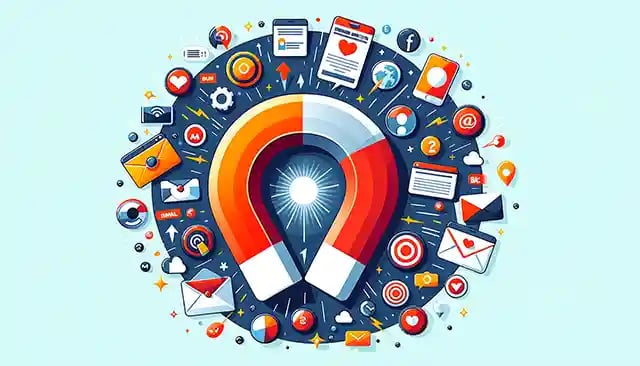
Understanding Inbound Marketing
Gone are the days when businesses would cast a wide net and hope for the best. Now, it's all about drawing customers in with something they can't resist: information that speaks to them directly. That’s where inbound marketing shines.
In essence, inbound marketing is like being the most charming person at a party; you attract everyone to you by being interesting, helpful, and genuine. It's how brands build an online presence that feels less like shouting into a megaphone and more like starting meaningful conversations.
Attracting Your Target Audience with Quality Content
To get started on your journey of becoming an inbound magnet, think quality content—blog posts so good they make readers forget their ads. This kind of content not only draws people in but also boosts brand awareness as it circulates through social media channels.
To attract customers, create blog posts or videos that answer real questions your potential customers have. When these folks hit up Google searching for answers—and let's face it, we all do—they find your stuff because you've mastered using those juicy relevant keywords without making it look forced (it’s art.). And voilà. You're now the top dog on search engine results pages (SERPs).
Engaging Potential Customers with Solution Selling
Moving along from attracting eyeballs to engaging minds—that’s where solution-selling steps onto the stage. We’ve waved goodbye to pushy sales tactics; now we engage by offering solutions tailored just right for our audience’s needs.
This means having heart-to-hearts via email marketing campaigns or providing demos that feel personal—even if thousands receive them. It shows you understand their pain points better than anyone else could claim—a strategic approach sure beats cold calling any day.
Ensuring Customer Satisfaction Through Delighting Strategies
Last but certainly not least: delighting strategies seal the deal on customer relationships stronger than duct tape sticks things together. Implement tools like chatbots and surveys post-purchase—not only does this show customers you care about their experience, it also gives them a direct line to voice their thoughts. By actively listening and responding to feedback, you're showing that every opinion matters and helps shape your service. This kind of attention can turn one-time buyers into loyal fans.
What is Inbound marketing? Think of inbound marketing as being the life of the online party. Draw in customers with quality content that answers their real questions, engage them by solving their problems, and keep them coming back for more by listening to what they say post-purchase.
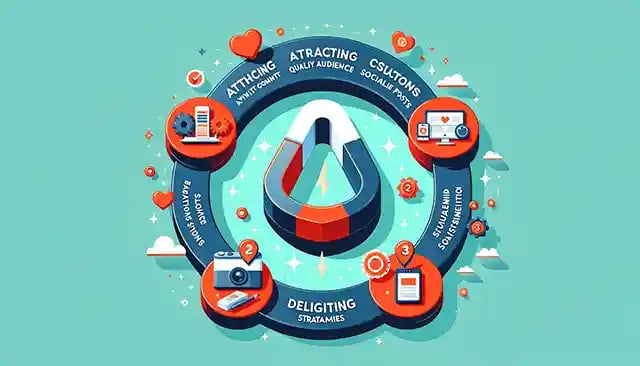
The Core Pillars of Inbound Marketing
Think of inbound marketing as a magnet. Instead of pushing messages out to people who might not even care, it pulls in the right crowd—like bees to honey. It's all about attracting folks with quality content, engaging them by solving their problems, and keeping them happy long after they've made a purchase.
Attracting Your Target Audience with Quality Content
Gone are the days when large companies could just shout into the void using dubious marketing techniques and hope for an echo. Today’s audience needs more; they want valuable content that speaks directly to them—and boy does this work wonders. Strike the right balance between your business's offerings and what your intended viewers yearn for, and you'll have success. Blogs, social media posts, eBooks—you name it—if it’s good stuff that answers real questions or solves actual pain points. People will come running. This type of inbound marketing attracts the right type of customers.
This isn’t just fluffy talk either; strategies aimed at providing solutions rather than pushy sales pitches are key here. And trust me when I say helping customers always pays off—even if there's no immediate business value in sight.
Engaging Potential Customers with Solution Selling
Moving on from grabbing attention is keeping it—that means engaging potential customers so well they can't help but want more from you. How do we flip the script from product selling to solution selling? Easy: listen up and tailor experiences like never before because let’s face it—a one-size-fits-all approach fits nobody perfectly.
You’ve got tools like HubSpot, let this strategy target your key personas, turning data into insights faster than a caffeine-charged analyst on Wall Street. With such resources at hand (think automation technology), personalized interactions aren't just possible—they're expected. Let this type of marketing create a new way of working and you will see strategies emerging that are innovative and effective.
Ensuring Customer Satisfaction Through Delighting Strategies
Last but certainly not least is making sure those smiling faces stay that way—delighted customers turn into repeat buyers and walking billboards for your brand loyalty club. Implement post-purchase support mechanisms like chatbots ready 24/7 or surveys asking “How did we do?” These may seem like small gestures, but they make a huge difference in cultivating lasting relationships. By showing you care about their experience after the sale, marketing inbound will reinforce trust and satisfaction.
Think of inbound marketing as a magnet that attracts, engages, and delights. It's about pulling in the right crowd with killer content, solving their problems to keep them hooked, and ensuring they stay happy even after buying. Quality over quantity is king; tailor experiences for your audience using smart tools like HubSpot for personalization that hits home.
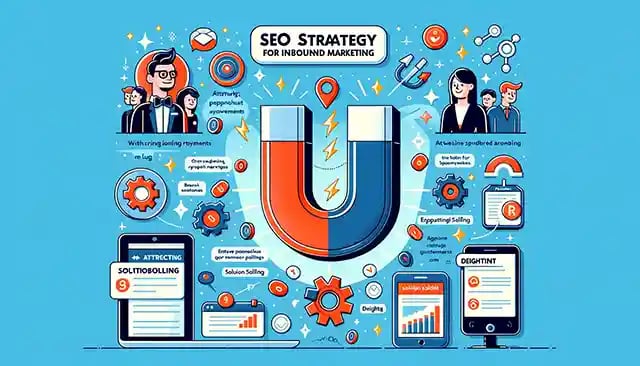
Crafting an Effective SEO Strategy for Inbound Marketing
Imagine your website as a magnet. Now, what you need is the right kind of pull—SEO strategy—to draw in visitors just like iron filings to that magnet. Crafting content that stands out on the search engine results page (SERP) isn't a matter of chance; it requires a plan.
Attracting Your Target Audience with Quality Content
Your first mission? Get noticed by those who matter most: your target audience. To do this, sprinkle relevant keywords throughout your content like magic dust—it helps Google see how relevant you are to what people are searching for. But beware of overdoing it. Just as too much glitter can ruin a craft project, keyword stuffing can damage your SERP rankings.
The key here is balance and relevance—finding and using terms that align seamlessly with both user intent and your brand’s message. A study once showed optimizing content around these golden nuggets could vastly improve visibility on search engines—and let's be real, we all want our names up in lights on Google's front row.
Engaging Potential Customers with Solution Selling
Gone are the days when flashy ads could win over customers. Today’s buyer is savvy—they seek solutions, not just products. That means engaging potential customers by addressing their pain points directly through well-crafted narratives within blog posts or articles—the stuff great inbound strategies are made of.
This approach doesn’t scream 'Buy me.' but whispers 'I understand what you’re going through,' thereby building trust—one step closer to turning leads into loyal fans.
Ensuring Customer Satisfaction Through Delighting Strategies
Last but not least: keep them coming back for more. Delighting strategies ensure customer satisfaction even after they’ve hit 'Purchase.' This involves setting up post-purchase goodies like chatbots for round-the-clock support or sending out surveys asking for feedback—all signalling to customers that hey, you're there if they need help fixing any issues or have questions along their journey.
Think of it like this: a business that nails every step, from drawing people in to making them smile long after the sale, creates an unstoppable cycle. It's all about building strong connections that keep customers coming back for more—a true partnership where success and customer satisfaction groove hand in hand.
Think of SEO as your website's magnetism—use it to attract the right audience with a balanced mix of relevant keywords and quality content. Engage them by solving their problems, not just selling products. Keep customers delighted post-purchase for an unstoppable cycle of satisfaction and repeat business.
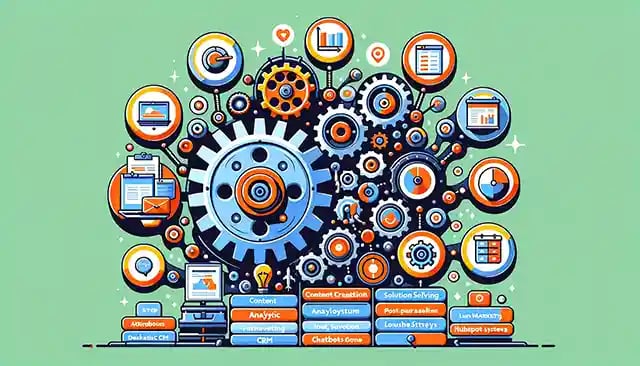
Leveraging HubSpot's Tools for Inbound Success
Think of your inbound marketing efforts as a well-oiled machine. Every component must be working in harmony to reach your desired outcome. That's exactly what HubSpot's marketing automation suite of tools is designed for—making sure every aspect of your strategy clicks into place, from content creation right through to lead nurturing.
Attracting Your Target Audience with Quality Content
The starting line in any race towards inbound success begins with attracting the right crowd. By using HubSpot’s comprehensive marketing software, creating valuable inbound marketing content that resonates becomes less about guesswork and more about precision. Their tools let you dive deep into analytics, understanding who visits your site so you can tailor your approach like never before.
This strategic move doesn't just draw people in; it sets the stage for long-term relationships because when folks find great content they trust, they stick around—and maybe even bring friends.
Engaging Potential Customers with Solution Selling
Gone are the days when throwing features at prospects was enough. Today’s buyer wants solutions, not sales pitches. With HubSpot's automation tools embedded within their CRM system, each interaction is an opportunity to learn and engage more effectively by providing solutions that matter.
Say goodbye to cold calling and hello to warm conversations centred on real needs—all tracked meticulously within one powerful platform.
Ensuring Customer Satisfaction Through Delighting Strategies
Your job isn’t done once a sale closes—you've got fans to make. This is where delighting strategies come into play: those thoughtful touches post-purchase that turn happy customers into raving advocates. Chatbots ready round-the-clock? Surveys tailored just so? You betcha. And thanks again goes out to HubSpot's arsenal—specifically their savvy automation technology.
HubSpot's tools turn your inbound marketing into a precision engine, attracting the right audience with quality content and engaging them through solutions, not sales pitches. Post-purchase, it helps create raving fans with delighting strategies that make sure every interaction counts.
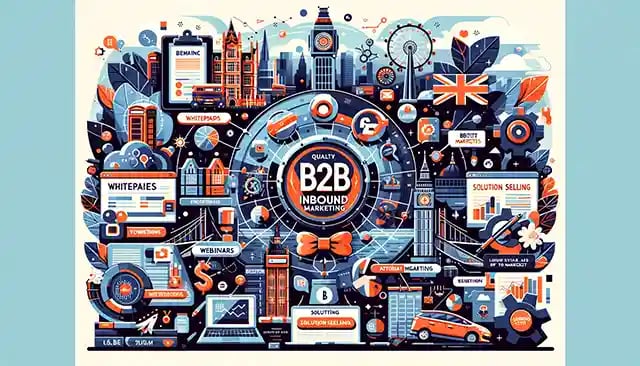
Navigating B2B Inbound Marketing in the UK Market
The game has changed for B2B inbound marketing, especially in the bustling and ever-evolving UK market. The focus? Crafting strategies that not only reach but resonate with your target audience. Financial services, tech startups, you name it—the goal is to become a magnet for businesses seeking solutions.
Attracting Your Target Audience with Quality Content
First things first: reel them in. But here's the catch—no bait and switch. You've got to be genuine by providing top-notch content tailored specifically for your British business crowd. We're talking whitepapers that cut through the fog like London on a sunny day or webinars as engaging as a chat over tea about how cloud computing can skyrocket efficiency.
Different types of content scattered across platforms ensure you connect at every buying cycle stage because one size doesn't fit all—not when it comes to tweed jackets nor inbound marketing strategies.
Engaging Potential Customers with Solution Selling
Gone are days when hard selling was king; now we listen before we speak—and oh boy do we provide solutions. Think Alfred Pennyworth from Batman—always there offering just what Bruce Wayne needs without pushing unnecessary gadgets. That's solution selling done right—a strategic approach perfect for discerning businesses searching for bespoke answers to their unique challenges.
Ensuring Customer Satisfaction Through Delighting Strategies
A sale isn’t an end—it’s just a beginning. Imagine delighting customers so much they sing your praises from Big Ben’s belfry—that’s our aim here. Tools like automated chatbots aren't just cool tech—they’re attentive digital concierges ready 24/7 to fix any hiccup faster than Sherlock solves mysteries.
Incorporate surveys too because feedback is more valuable than finding loose change under couch cushions—it guides us towards excellence in customer experience while also keeping those conversations going long after deals are sealed.
Think of B2B inbound marketing as being a helpful guide in the UK market. You need to draw in your audience with quality content—no tricks, just treats like insightful whitepapers and captivating webinars. Listen up and sell solutions, not products. Keep customers so happy they can't help but share their great experience.
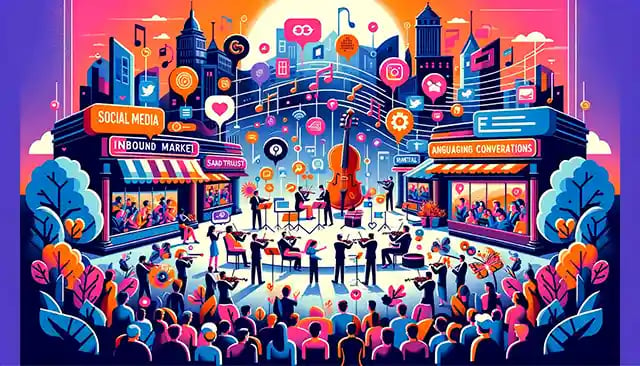
Social Media's Role in Inbound Marketing Strategy
Think of social media as the bustling marketplace of inbound marketing. It's where conversations thrive and relationships bloom, with every like, share, and comment weaving together a tapestry that elevates brand presence.
Attracting Target Audiences Like Bees to Honey
Digital marketing has become a symphony orchestra, and social media management is the lead violinist setting the tone. With strategic posting on platforms galore—each tweet or story tailored for potential customers—you're not just shouting into the void; you're singing directly to those who want to hear your tune. Social media turns brands into magnets attracting people who resonate with their message.
The magic happens when target audiences stumble upon content so compelling they can't help but follow along. That's creating valuable connections without even whispering "Buy now." And because let’s face it: No one likes being interrupted by ads during their daily scroll-fest.
Engaging Conversations That Build Brand Trust
Gone are days when businesses could hide behind logos and taglines; today’s digital world craves authenticity more than ever before. Through posts that spark discussions or live Q&A sessions on Instagram stories, companies have unique opportunities to cultivate brand loyalty through genuine engagement—a surefire way to delight customers.
Your fans aren’t just numbers in an analytics report—they’re real folks looking for experiences tailored just for them. By listening intently (HubSpot calls this social media listening) and responding thoughtfully, you don’t only assist customers; you make them feel heard—boosting customer experience big time.
Nurturing Leads Without Breaking a Sweat
We've all been there – trapped under mountains of emails trying desperately not to get lost in spam folders. But fear not. Enter email marketing: A personalized powerhouse within our effective inbound framework designed precisely for nurturing leads down that conversion yellow brick road toward loyal patronage city.
Email campaigns mesh seamlessly with social initiatives like two peas in an online pod – think targeted messages following up after someone downloads your latest e-book from Facebook ad click-throughs or exclusive offers snapped up via Instagram Stories swipe-ups. This synergy creates a dynamic duo that drives engagement and conversion, making the most of both platforms.
Think of social media as your brand's voice, reaching out and drawing in audiences with posts that hit home. It's all about creating a buzz without the hard sell, sparking conversations that build trust and loyalty. And when you pair this with smart email marketing? You've got yourself a winning combo for nurturing leads and growing your fanbase.
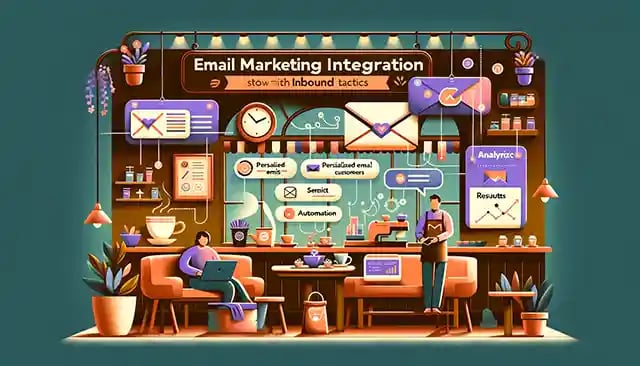
Email Marketing Integration with Inbound Tactics
Looking for an inbound marketing definition? Think of your favourite cosy coffee shop. It's not just the java that brings you back, but how they remember your name and order. That’s email marketing in the inbound world—it builds loyalty with current customers by making them feel special.
Personalization: The Heartbeat of Email Engagement
You've got mail—and it's not a one-size-fits-all message. Crafting emails tailored to customer interests can make a huge difference. By analysing past purchases or content interactions, businesses send out relevant offers and articles that resonate on a personal level and build long-term relationships. This is no cold call; it’s like getting an invite from an old friend.
Say goodbye to bland "Dear Customer" greetings because addressing recipients by their names is just step one. Segmentation goes further—dividing those lists into categories like recent buyers or frequent browsers ensures each email hits home harder than Cupid’s arrow on Valentine's Day.
Leveraging Automation for Timely Touchpoints
Gone are the days when sending thousands of emails meant pulling all-nighters. Thanks to automation technology, hitting 'send' happens while you sleep. Setting up triggers based on user actions keeps communication flowing without clocking in extra hours at work.
This isn't about bombarding inboxes but rather nurturing relationships over time—a friendly nudge here when someone abandons their cart or there after downloading your latest e-book—all timed perfectly to keep leads warm until they're ready for more coffee... I mean, ready to convert.
Analysing Results To Sweeten Your Strategy
Digital marketing isn’t guesswork; it’s marketing based on science mixed with artistry and spiced with data analytics magic to deliver a custom experience through an effective inbound marketing strategy. With tools from platforms like HubSpot, tracking open rates and click-throughs gives insights into what works best for engaging potential customers through emails as part of your larger inbound efforts.
The numbers tell stories—you'll learn which subject lines have people eager to click faster than kids opening presents Christmas morning or understand why certain campaigns performed better than others so you can repeat those successes (minus any holiday wrapping paper) turning a prospect into a valuable customer.
Personalize your emails like a cosy coffee shop knows your favourite drink—make customers feel seen with tailored content and offers. Use segmentation to ensure each message hits the mark, and let automation handle timely engagement. Analyze results to constantly improve; it's all about mixing data-driven decisions with creative flair.
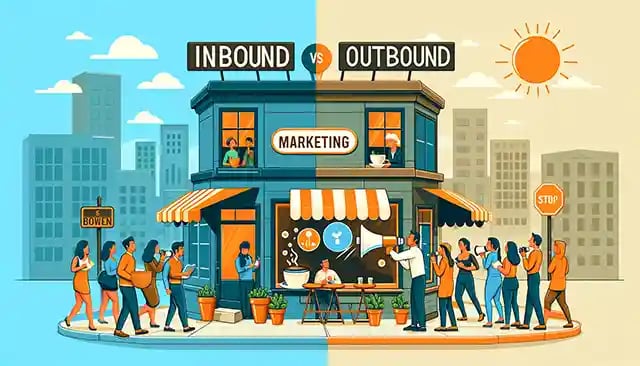
Comparing Inbound vs Outbound Approaches
When it comes to marketing, the battle between inbound and outbound is like choosing between a quiet coffee shop chat or a megaphone on a busy street. Each has its place, but boy do they differ.
The Cost-Effectiveness of Inbound Marketing
In one corner we have inbound marketing, where your target audience comes to you like bees to honey. This strategy focuses on creating valuable content that attracts people naturally. It's kind of like hosting an amazing party—everyone wants in. Now consider this: by building long-term relationships through engaging and assisting customers with helpful information, businesses are playing the long game but at a fraction of the cost compared to traditional advertising.
In contrast, outbound tactics can often feel more intrusive than an uninvited telemarketer during dinner time. These methods typically involve higher costs for lower engagement rates because let's face it – nobody likes ads interrupting their favorite show.
Better Targeting Capabilities with Inbound Methods
Dial down on those who want what you're selling. That’s inbound marketing's forte. Imagine fishing in a lake stocked with fish you know love your bait—that’s how well-targeted this approach allows us to be thanks to SEO strategies that convert leads into loyal fans by meeting them right when they’re searching for solutions online. The trick lies in optimizing content so Google Ads serve as friendly signposts rather than pushy salespeople.
Moving over to outbound land—we've got techniques throwing wide nets hoping something sticks (think cold calls). Sure, sometimes you'll catch something good; other times... not so much.
Cultivating Brand Trust Through Authenticity
A strong brand trust doesn't happen overnight—it needs nurturing just like any relationship worth having does. With effective inbound practices, companies engage directly with potential customers providing experiences tailored specifically for them—a gesture that goes miles towards establishing authenticity and transparency. But wait—there's more.
HubSpot says, "Effective inbound efforts centre around creating meaningful interactions," which echoes why these strategies gain popularity among consumers
Think of inbound marketing as hosting a killer party where everyone's dying to come, while outbound is like being that pushy telemarketer. Inbound wins with cost-effective methods and spot-on targeting—like fishing in a stocked pond—and it builds trust by tailoring genuine experiences for your audience.
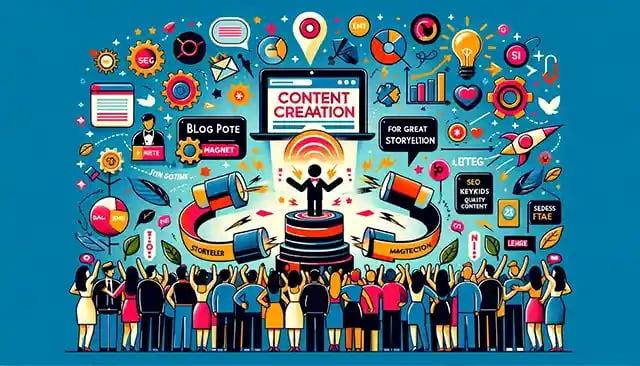
The Advantages of Using Content Creation for Lead Generation
Imagine this: You're at a party, and instead of pushing flyers into people's hands, you become the go-to storyteller that everyone gathers around. That's what great content does on your website—it turns you into the life of the online party, attracting people who hang onto your every word.
SEO Keywords: Blog Post, Great Content, Attract People
You've probably heard it before—content is king. But let me tell you why. Crafting blog posts that resonate with readers can be like using a magnet in a pile of paperclips; it draws them right to you. When these posts are peppered with SEO keywords smartly woven throughout, they don't just attract any crowd—they bring in the exact group itching for what you have to offer.
Sure, Google Ads has its charm for quick visibility boosts but think long-term and organic—that’s where consistent great content pays off big time. And here’s something spicy: when done right, each post lives on far beyond its publish date as an evergreen beacon beckoning new leads year-round.
Crafting Magnetic Marketing Content
We’re not talking about slapping together some words and calling it good enough. No way. We're diving deep into creating valuable content so irresistible that potential customers can’t help but bite—and keep coming back for more because they trust your brand expertise.
This isn't about making noise; it's strategic storytelling mixed with psychology and understanding human behaviour—a cocktail designed to draw folks through every stage of their journey from 'just looking' down that sales funnel till they hit 'buy.'
Drawing Interested Parties Into Your Sales Funnel
It’s one thing getting eyes on your page; another ball game entirely is keeping those peepers there until curiosity turns into action—a sign-up or sale perhaps? Here comes inbound marketing flexing its muscles again by offering exactly what our target audience craves before they even know they want it.
A blog post answering their burning questions or solving pesky problems doesn't just say "Hey look at me." It whispers (or shouts), "I've got the answers you're looking for." When your content hits the mark, it's like giving readers a secret handshake—they feel understood and trust that you know your stuff. So, make sure each piece is not only informative but also engaging; let them know they're in good hands with your expertise guiding the way.
Great content is like being a magnetic storyteller at a party—it draws people in and keeps them hooked. Use strategic storytelling with SEO smarts to attract the right crowd, offering value that turns curiosity into action.
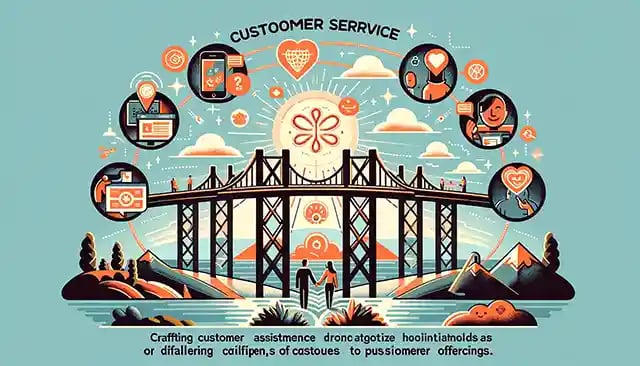
Enhancing Customer Service Through Inbound Practices
In the world of inbound marketing, customer service is more than just solving problems—it's about building a bridge between what customers need and what your business offers. Think of it as less of an emergency hotline and more like a friend who’s always there to help out. This strategic approach can make all the difference in nurturing long sales cycles and turning one-time buyers into lifelong fans.
Assist Customers Proactively Across Multiple Channels
Today's savvy businesses know that waiting for customers to reach out is so last century. By integrating social media management with proactive customer service, you're essentially rolling out the red carpet before they even ask for it. You anticipate their needs, offer solutions on their preferred platforms, and do it with style—and by style, we mean personalization that feels like a warm hug from an old pal.
To nail this down, use automation technology but keep it human; think chatbots that don’t sound robotic or email marketing strategies that feel like they were penned just for them. It shows you’re not only listening but also ready to assist at lightning speed—a surefire way to build loyalty among current customers.
Create Experiences Tailored To Their Journey
The beauty of inbound practices lies in crafting experiences tailored specifically for different stages of your audience’s journey. Whether they're still getting acquainted with your brand or have been loyal supporters since day one—they should always get VIP treatment because every interaction counts towards building brand trust.
This means ditching generic responses in favour of personalized attention that understands where they are in their buyer’s journey—be it learning through valuable content on your blog post or seeking support after making a purchase. When done right, this method doesn't just delight customers; it makes them feel understood on a whole new level—which is pretty much a relationship goal.
Leverage Long Sales Cycles With Patience And Empathy
A lengthy sales cycle isn't something to fear when you've got inbound techniques up your sleeve. The key here is patience paired with genuine empathy—not just seeing dollar signs every time someone pings customer service.
It's all about grasping their hesitations and addressing them head-on. By demonstrating our commitment to their needs, we can build a connection of faith and dependability with our customers. They'll know that we're not just here to sell; we're here to support them every step of the way.
Turn customer service into a friendship with proactive support across channels, creating personalized experiences that build trust and loyalty. Show empathy in every interaction to foster long-term relationships, even when sales cycles are lengthy.
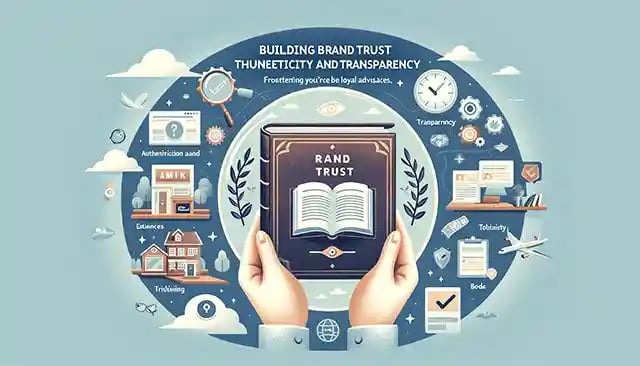
Building Brand Trust with Authenticity and Transparency
Trust is the foundation of any strong relationship, especially between brands and their customers. When a brand operates with authenticity and transparency, it's like an open book – what you see is what you get. And let's be real, in today’s world where social media can make or break a reputation in seconds, being upfront isn't just nice to have; it's crucial.
Authenticity: The Heartbeat of Your Brand
The secret sauce to gaining popularity as a brand? Be yourself. But not just for show – your actions need to back up those tweets and posts. For instance, if your marketing content says you're eco-friendly but your products are wrapped in layers of plastic, customers will call bluff faster than you can say "recycle." It's all about walking the walk that aligns with talking the talk.
This doesn't mean perfection—it means owning up when things go sideways because they sometimes will. Did something not quite delight customers as expected? Don’t hide—shine a light on how you'll fix it. Brands that are honest gain respect from their target audiences way more than those playing pretend.
Transparency: Clear as Glass Communication
Surely everyone loves surprises…except when it comes to customer experience or hidden fees (looking at your airlines). By giving clear information upfront about services or costs—and sticking by them—you help build loyalty among current customers who then turn into vocal advocates for your brand's trustworthiness.
Beyond pricing strategies involve openly sharing company values and processes which resonate strongly within B2B circles too. Remember though; this isn’t only applicable during sunshine-and-rainbows scenarios but also through stormy weather such as public blunders or service hiccups.
Fostering Loyal Advocates Through Genuine Interactions
Loyalty isn't bought; it’s earned through experiences tailored around genuine interactions that cultivate brand affinity over time. Let’s take email marketing—a powerhouse tool—inbound tactics here revolve around personalization rather than spamming folks with irrelevant offers until they hit unsubscribe out of sheer annoyance.
A strategic approach involves crafting messages that resonate with your audience. To do this effectively, you'll want to dive deep into understanding their needs and preferences. Customize your expression of speech fittingly; it's not just concerning what you verbalize but how you articulate it.
Build trust by being real and transparent. Actions should match words, and clear communication is key. Remember, loyalty comes from genuine connections over time.
FAQs about What is Inbound Marketing
What is the meaning of inbound marketing?
Inbound marketing draws customers in with content they value, rather than pushing ads onto them.
What are examples of inbound marketing?
Blogs, eBooks, and SEO-focused articles shine as classic examples of inbound marketing at work.
What is inbound vs outbound marketing?
Inbound woos customers with helpful content; outbound goes after them with direct sales pitches.
What are the 4 elements of inbound marketing?
The big four: attract with content, convert via forms, close using CRM tools, and delight through service.
Conclusion
So, what is inbound marketing? It's your brand's secret weapon. By now, you've seen how it can charm and engage by creating valuable content that ranks high on search engines.
Dive into crafting blogs or using SEO to put your business in the spotlight. Leverage tools like HubSpot to streamline every step of the journey from attracting to delighting customers.
Embrace social media management for a genuine connection with your audience. And don't forget email marketing as an ace up your sleeve for nurturing those precious leads.
Inbound isn't just about closing sales; it’s about opening relationships. Tailor strategies for B2B or any market and watch automation turn prospects into partners.
Now you're equipped with insights on effective inbound marketing—strategies that not only draw people in but keep them coming back for more. Remember, when done right, inbound turns strangers into loyal fans of your brand story.




